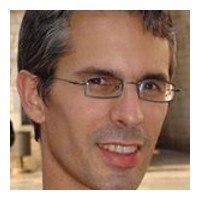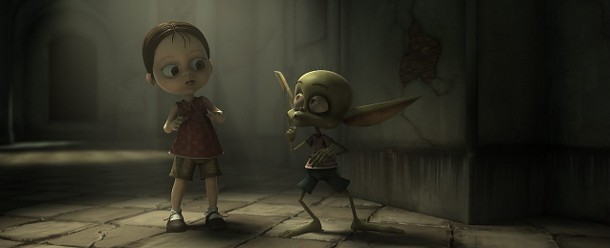Q&A: Erwan Maigret, director, The Bakery
 French developer The Bakery hit the news earlier this year when co-founder Arnauld Lamorlette won an Academy Award for his work on GI: research carried out at DreamWorks Animation in the early 2000s.
French developer The Bakery hit the news earlier this year when co-founder Arnauld Lamorlette won an Academy Award for his work on GI: research carried out at DreamWorks Animation in the early 2000s.
But Lamorlette isn’t the only key Bakery figure to have worked at that level in the industry. Executive director Erwan Maigret is also a Hollywood veteran, and their first product, relighting and rendering tool Bakery Relight, is designed to address the way real artists work in production.
Bakery Relight replaces conventional final-quality renderers like RenderMan or mental ray in the production pipeline, enabling artists to view changes to the lighting and shaders in close to real time.
We spoke to Maigret about what his software can do, the challenges of creating an artist-centred lighting pipeline, and why the revolution in rendering will begin in the Far East.
CG Channel: What made you feel the time was right for a dedicated relighting solution?
Erwan Maigret: For 20 years, you had the rendering engine on one side [of the production pipeline] and the DCC tool on the other. You would create a 3D scene and then render it out. Then everybody tried to replicate what we used to do with the CPU, but with graphics cards, which was much much faster, but you had to cut down on the quality. That was not very successful, so everyone moved back to the CPU for rendering.
My partner [Arnauld Lamorlette] and I were working in production at the time, and the reality there is that people are not looking for the fastest rendering engine, but quality control and management of complexity: the aim is to ramp up during production in such a way that [workflow] stays linear. When you are a small production, you can do everything, but when you get bigger you need to get more organised, and the software on the market just didn’t [allow you to do that]. It was fine for commercials but not for movies or 3D TV series. The rendering times were very high and you didn’t have control of the final image direct in the [renderer].
Relight is about being able to work on the final image, and second, to be able to scale up regardless of the complexity. The point is to optimise the workflow based on how [artists really work]. What we sell is not super-fast, but people perceive it that way because now they can get some artistic work done: they’re not being paid for wasting hours in front of a screen.
CGC: So how would you sum up what Bakery Relight does?
EM: It’s a software technology aimed at very high-end 3D CG animation but in a way that you can do everything using the mix of [lighting and rendering] techniques that already exist. We don’t impose anything on the user. People can work on an image without really having to think about technique any more.
CGC: How does it fit into a pipeline: if you’re using Maya, for example?
EM: Relight takes whatever a standard render engine takes, which is usually simple geometry, UVs and textures. That asset information and the camera position is taken into Relight and the whole shading and lighting [process] is done there. We don’t get shaders out of Maya because those aren’t Maya-specific: they’re from mental ray or whatever traditional render engine you’re using. All that has to be done in Relight.
We specialise the export plug-in to [a studio’s pipeline] in such a way that they can get from Maya to Relight by clicking a few buttons. We do that with Maya, with [Softimage], with Max. [That process] is dealt with my team, because it has no interest for artists.
Even if you have a single licence of Relight, you get that support, and you get a bunch of examples showing how you can integrate from Maya: export scripts, and so on. But then it really depends on how you do your asset management and asset organisation, so it’s usually back and forth with our team.

One of The Bakery’s in-house tests. Fur is baked out as a specialised type of point cloud.
CGC: I see that Relight has some fur and fluids tools. Are you expecting simulation to be done inside Relight?
EM: When you’re inside of Relight, it’s about static per-frame image control. Everything to do with simulation comes first, outside. But we still need to be able to render fluids, volumes, all those types of things. So that all has to be baked out [for import into Relight] – The Bakery is all about baking anyway. We bake a cache so we become completely independent of whatever happened before.
It’s true – and this is maybe what you’re referring to – that we have particle trees [inside Relight]. They’re complementary [to the lighting and rendering toolsets]. With some clients, we specialise those tools so they can do those things in Relight without having to go back and forth between software packages.
We’re starting to do some fur painting, and we’re going to do some dynamics because people don’t want to have to script it out. We don’t plan to become a full-blown traditional animation package: just to give the lighting people [a suite of tools] to do everything they want.
CGC: Relight also contains compositing tools. Do you envisage it replacing packages like Nuke?
EM: Studios have this habit of using compositing to do relighting by baking layers so they can reassemble them in a 2D package. You don’t need a very complex compositing tool to do that. If you do post-production with effects and live-action integration, it makes more sense. But Relight is more about people who do full 3D CG. If they just need to assemble layers [they don’t need Nuke or Toxik] – what we have in Relight can do that.

Bakery Relight client Cyber Group Studios is working on 52-part animated series Zou.
CGC: So your clients are working mainly on cartoon animation, not photorealistic effects?
EM: It’s a mix. Hawaii Animation Studios works on dinosaurs, creatures with fur. But I have to say that more people are more inclined to do the 3D CG stuff.
CGC: Relight replaces a studio’s existing final-quality renderer. Isn’t it a tough sell to persuade facilities to ditch all the work they’ve done on RenderMan?
EM: Of course: it’s a big change. People want to use one renderer at a time, and if they want [to do that] they have to substitute it completely. For studios that have been around for a long time, it’s going to take time [to switch over], and they know that. So for us, this is more complex. We need to work together on the way they handle their pipeline.
But if it’s a smaller house, they usually have multiple render solutions, in which case it’s easier to bring in another renderer. They usually use [each renderer] for one specific solution: to raytrace, for example, or if they have a lot of fur or vegetation. We bring a solution that can do both at the same time, so it’s very sexy for them.
CGC: So what size are your current clients?
EM: Some of them are larger studios – I think there are around 40 people in Hawaii – and some of them are just ramping up. We work a lot with [international] co-productions. It’s fun to look at how you share data between sites, and how you can optimise them using our technology.
There’s a lot going on in Asia, so I think I’m going to spend a lot of time over there. We’re working with several clients in Japan, including NHK, and a studio in China working on a 3D TV series. That’s pretty heavy.

Look development for the animated feature Ana, conducted in Bakery Relight by Mexico’s Lo Coloco Films.
CGC: You mentioned GPU acceleration earlier. Relight is purely CPU-based. Can you explain why?
EM: We do some GPU acceleration when you’re in the UI [and] to bake shadow maps, but we try to avoid it, and we guarantee that everything can be done in CPU. That means [the hardware] you need is pretty limited. You don’t need much RAM – though the more processors the better, obviously – and you don’t need a good graphics board. So clients save $500 to $1,000, just on the graphics, and then they’re guaranteed that everything is going to work [in the renderfarm] just like it does on their workstation. That’s a pretty big deal.
CGC: How does what you’re doing with Relight compare to The Foundry’s work on Katana?
EM: Katana, in some respects, is pretty similar to Relight: not in the rendering, but in the architecture. Katana is a big scene-management system – a render asset manager, to some extent – so the scene graph for presentation, which is usually the biggest part of the pipeline in a studio these days, is exactly what we do.
But those aren’t the competing aspects. Katana is a render asset manager that can let studios with multiple types of renderers [control how they fit together in a pipeline]. It’s a good complexity manager. But we’re not taking that approach: the reason the interactive aspect of Relight is important is that it’s not about complexity management – that’s something we do well, but you can only do relighting if you have a very tight relationship with the render engine, which in our case is fully integrated into the tool itself.
We developed a lot of techniques for caching sub-pieces of the rendering so instead of going 100 times faster, we only [have to] do one per cent of the rendering. That’s not what Katana is aiming at: they just want to be able to deal with multiple renderers, no matter what they are. On our side, we guarantee that you can do lighting on very complex scenes from the get-go and get to the final render in seconds, which is different from managing the complexity of the scene.
CGC: So where next for Relight? What new features are you working on at the minute?
EM: The big new features have to do with the way we’re integrating cloud computing. Most of our clients just want to cut down on their costs, and to do that, they don’t want to invest in the hardware initially: they want to rent it per diem. That’s the reason we’re starting a partnership with Microsoft and with another cloud-computing system in Europe: so that we can propose to the client that you have access to a whole cloud-computing renderfarm from Relight. It’s like a virtual studio to some extent, but without the initial investment.
As a renderer itself, it’s still in development; there are some things that are going to be added. But the next big things for us are cloud computing and [extending] rendering from pre-viz through to the end of the pipeline. It’s a technology about how we see the future.
